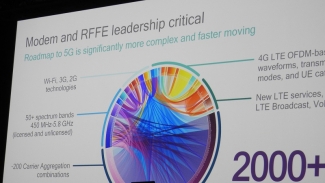LAS VEGAS--Qualcomm Technologies EVP and CTO Matt Grob received almost as much cell phone selfie love as billionaire investor Mark Cuban when Grob presented slides showing just how complex the technical journey has been leading up to 4G and coming with 5G.
Presented during his keynote at CTIA Super Mobility 2016 just minutes before Cuban took the stage for a chat with AT&T’s Glenn Lurie Thursday, the slides showed how many technologies and spectrum bands are accommodated for by today’s networks and devices and what will be required in the future.
“I want to give you a sense of the complexity and what the accomplishment that the industry is going to achieve out of 5G, what it represents,” he said.

He presented a slide that Qualcomm showed at an analyst meeting in 2012 to illustrate the complexity of the technology, including CDMA, W-CDMA, LTE, Wi-Fi and more, with myriad lines representing all the different handoff combinations, and “man, that looks complicated. When we first saw that, we thought wow, how are we going to get that done, but we did.”
Now, looking at today’s situation, “you can’t even draw a picture like that. You have to use new ideas just to draw it,” he said, showing a circle of colors. “Basically what you’re looking at here is a tool that was also used as a graphic tool to map the human genome.”

Around the outer edge of the diagram are more than 2,000 modem features and every one of them is commercially tested. Three-fourths of them have a counterpart in the network, giving a sense of what it takes to deliver a modern cellular modem. There’s a lot of testing with operators and vendors – and that’s today.
With 5G, the picture changes even more by adding millimeter wave and the different spectrum types and licenses and vehicle-2-vehicle and more mission-critical applications, including for the ability to have drones help firefighters during emergencies rather than be a hindrance by hobbyists.
“It’s an incredible thing that’s happening, it’s really a big deal for Qualcomm and the industry,” with more partners and companies participating than ever before and there’s still a lot of innovation going on, he said.
Grob also discussed the work Qualcomm is doing with AT&T to study the operation of drones on Qualcomm’s campus in San Diego that just happens to be classified as Class B airspace, so the company had to go through all the processes to get proper certification from the FAA to conduct tests there.
The trials will analyze how drones can operate safely and more securely on commercial 4G LTE today and networks of the future, including 5G.
The overall timeline for 5G is dependent on the standards process right now, and it’s geared toward launching NR type services in the 2018-19 timeframe. However, there are significant advances coming before that, he said.
Grob also showed photos of some prototypes that are being tested for fixed and mobile. “It’s not just slides,” he said. “In fact we’ve been working on this for years. We just keep going.”
Earlier, Verizon EVP and President of Operations John Stratton discussed the challenges and rewards of moving to the Internet of Things (IoT), and like some other keynote speakers at CTIA, he said it’s critical to put the human experience of technology at the center. Addressing real societal issues and driving economic growth using the technology will be key. If done effectively, it could improve quality of life for communities by making them safer, cleaner and more energy efficient.
Related articles:
AT&T, Qualcomm to test drones on commercial LTE networks
Qualcomm CEO bullish about prospects for 5G
Qualcomm: We're working at a feverish pace to develop 5G tech

